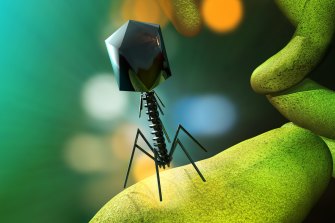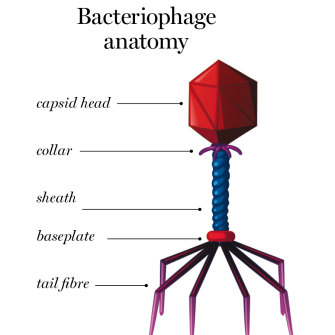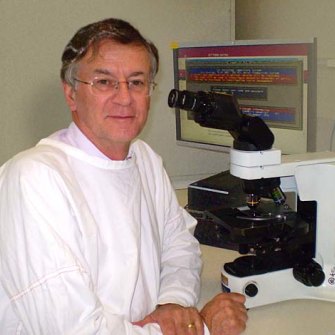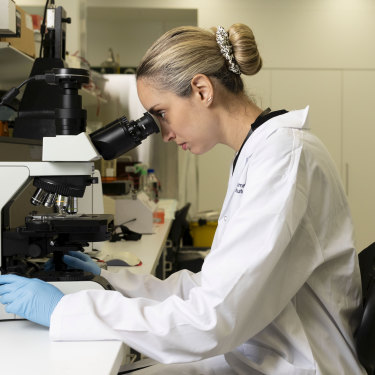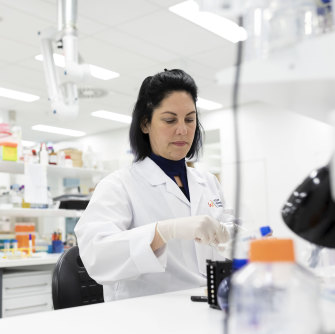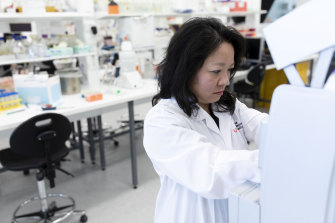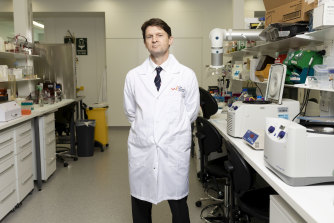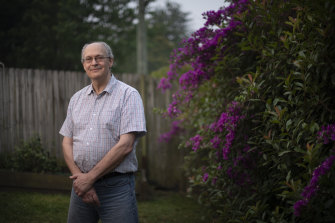Just after 10pm on a still Sunday night in March 2016, Jeremy Barr, having cleaned up the dinner dishes in his San Diego apartment, was thinking about bed when his mobile phone buzzed into life with a FaceTime call. Barr instantly recognised the mane of striking salt-and-pepper hair and trimmed beard on the screen. It was his laboratory supervisor at San Diego State University, Professor Forest Rohwer, one of the world’s leading microbial ecologists, and his tone was urgent.
Rohwer, a 47-year-old with a thoughtful demeanour, began quizzing the young scientist from Brisbane about his research into bacteriophage therapy – “phage therapy”, for short – which turns viruses into chemical weapons against antibiotic-resistant bacterial infections. Rohwer was curious about how Barr removed toxins from phages, so they were safe to use in humans.
“What’s this about Forest?” interrupted Barr, who’d been working at Forest’s San Diego lab for four years on a postdoctoral fellowship. Rohwer explained that a local man had contracted a superbug while on holiday in Egypt and the most powerful antibiotics had failed to work. Now on the brink of multi-organ failure, the man would almost certainly die within days unless the infection could be stopped in its tracks. Could bacteria-eating phages be put to work to kill the deadly disease?
Phages, unlike antibiotics, are not drugs. Rather, they are hunt-and-kill viruses.
Both men were aware of the perilous risks of such a procedure. Phages, unlike antibiotics, are not drugs. Rather, they are hunt-and-kill viruses that inject their DNA into bacteria cells, causing the bacteria to burst and die.
The downside is that when the bacteria burst, they also release poisonous impurities and endotoxins, which can kill a person quickly with septic shock. That’s why it’s vital the phages be “scrubbed” clean of these endotoxins, without damaging or deactivating the bacteria-zapping viruses.
Could Barr perform this critical task of purifying the phages, sourced from laboratories across the US, within a couple of days, Rohwer enquired. Barr did a quick mental calculation. “Yes,” he said. “I reckon it’s doable.”
But Barr, a tall, slim, fair-haired 30-year-old, was terrified the moment he hung up. He’d never prepared anything for human trial before; his was still an experimental treatment. And this would be the first case in the US of a person receiving intravenous phage therapy for a systemic superbug infection that antibiotics couldn’t treat.
About 20 minutes’ drive away, at Thornton Hospital at UC San Diego Health, the patient in question, a 69-year-old man, a lifelong surfer who’d always been super fit, was hooked up to a maze of tubes, including a respirator, in an induced coma.
A. baumannii now shares top billing with two other superbugs listed by the WHO as being the most dangerous to human health.
Tom Patterson’s swollen stomach contained a pseudocyst (a pocket of fluid) the size of a football and his body was swimming with a deadly, multi-drug-resistant superbug, the bacterium Acinetobacter baumannii, sometimes dubbed “Iraqibacter” for its signal talent for striking wounded soldiers during the last Iraq War. (A. baumannii now shares top billing with two other superbugs listed by the World Health Organisation (WHO) as being the most dangerous to human health.)
Patterson had been in a coma for weeks and had lost 45 kilograms from his formerly athletic, strapping 6 feet 5, 100-kilogram-plus frame. Only months earlier, in late November 2015, Patterson and his wife, Steffanie Strathdee, had been holidaying in Egypt.
Just hours after enjoying a romantic moonlit dinner on the top deck of a cruise boat on the Nile, Patterson developed nausea and vomiting, which he’d initially dismissed as food poisoning (the intrepid couple had had their share of stomach bugs during their many trips, and routinely packed the antibiotic Cipro). But when he developed severe diarrhoea and a fever, Patterson was rushed by ambulance to a local medical clinic. Within hours the pain was so excruciating the hairs on his head burned.
Patterson’s condition worsened over the next few days, to the extent he could no longer even get up to go to the bathroom. Overcome with a growing sense of panic, Strathdee pressured the doctors, who diagnosed pancreatitis.
After two weeks of not responding to treatment, looking deathly pale and losing weight, Patterson was medivaced to Frankfurt Hospital in Germany. Here, doctors discovered a pancreatic cyst teeming with A. baumannii. The only antibiotics that had any braking effect on the microbes’ lethal spread were the powerful meropenem and tigecycline, and the “big gun” colistin, a drug of last resort because it can lead to kidney damage.
By the time Patterson was airlifted home to San Diego – to the intensive care unit at Thornton Hospital – he was delirious, imagining (among other things) that there were hieroglyphics on the walls. He had become resistant to the big three antibiotics administered to him intravenously. Even worse, A. baumannii had migrated through his whole body. He was placed in a medically induced coma.
So much for the dark part of the story; now for the moment of serendipity. Patterson’s wife Steffanie Strathdee was an infectious disease epidemiologist at UC San Diego (UCSD), where Patterson was a professor of psychiatry. Refusing to give up on her husband, Strathdee had been researching A. baumannii – and treatments to fight it – via PubMed, the search engine of the National Library of Medicine, for some weeks.
One night in February, 2016, she researched phage therapy in more detail, compiling a list of US phage researchers. Her mind drifted back to studying phages in virology classes as an undergraduate. Derived from the Greek term phagein, meaning “to devour”, phages were once medicine’s great hope, after these bacteria-eating viruses were discovered in England and France during World War I, and later employed with mixed success.
An artist’s illustration of a phage virus attacking bacteria.Credit:Getty Images
But after the mass production of the more reliable, easier-to-use antibiotic, penicillin, in the mid-1940s, phage research was left behind – and eventually forgotten – in the West, although it remained popular in the Soviet Union (Stalin was a fan of phage therapy). It’s still possible to buy generic phages over the counter in Russia, Poland and Georgia, but they are only effective if they match the specific bacterium causing the infection, so can be unreliable.
The difference between the phage therapy of the past and today is DNA technology, which allows phages to be matched for their specific bacteria-killing properties. Now, with time running out, Strathdee appealed to Dr Robert “Chip” Schooley, professor of medicine in the division of infectious diseases at UCSD, who, although sceptical at first, helped her locate a selection of phages specifically designed to fight the malevolent invader killing her husband, which sequencing showed was an Egyptian strain of A. baumannii.
Researchers from three US laboratories forwarded the phages and they were granted emergency approval for use from the US Food and Drug Administration.
The tiny bacteriophages, housed in sealed plastic tubes, arrived at Barr’s lab in the late afternoon after Rohwer’s phone call the night before. Dressed in his regulation white lab coat, plastic goggles and rubber gloves, Barr set about stripping the phages of their toxins, a long and painstaking process involving successive washes, cooling and spinning treatments in a centrifuge. What he had to avoid at all costs was damaging or destroying the phages: these were the only batches available.
A phage resembles an alien spacecraft with spindly legs that lock on to the surface of the much bigger bacterial cell.
In the early hours of the following morning, a weary Barr placed the cleaned phages in a speed vacuum to boil away the residual alcohol, a process that would take five hours. Then he went home to grab some sleep.
And wait.
Since his days studying microbiology at the University of Queensland in his 20s, Barr had been fascinated with phages. Under an electron microscope, a phage resembles an alien spacecraft with spindly legs that lock on to the surface of the much bigger bacterial cell. Here it penetrates the bacterium’s protective shell and takes over its cellular machinery to produce more phages.
Overwhelmed by the invader, the bacterium dies, releasing a flood of new bacteria-gobbling phages.
When Barr returned to the lab the next morning, everything appeared to have gone smoothly. But the phage testing kit, which compared the results before and after endotoxin removal, repeatedly failed – and his heart sank. Another had to be despatched from Germany, which set him back another day.
After 24 hours of intense frustration, Barr faced the moment of truth with the new testing kit’s colourimetric read-out: bright yellow marked a high and dangerous endotoxin level, clear indicated a low safe level. When it came up clear, Barr almost jumped for joy and immediately buzzed Forest Rohwer, who got in his car and drove the phages, packed in a freezer box with ice packs on the passenger seat, straight over to the hospital.
Dr Schooley pumped the first of five phages directly into Patterson’s pseudocyst via catheters, and followed this up with an intravenous injection of the remaining phages.
On the evening of March 19, 2016, Patterson awoke from his coma for the first time in more than two months, turned to his eldest daughter and kissed her on the hand. Even though the bacteria developed resistance to the initial phages, and Patterson slipped into septic shock the following week, Schooley’s team fought back the infection with more phages, while Barr kept adjusting the cleaning protocol to keep them safe. After three months and another setback, Patterson’s infection was completely under control and, in August, he was discharged.
Illustration of Bacteriophage anatomy.Credit:Getty Images
The case grabbed international headlines when it was announced to the press in early 2017, and since then there have been a number of remarkable victories with phage therapy, including the recovery of a 16-year-old girl with cystic fibrosis in Kent, England, whose life was threatened by a strain of mycobacterium,and a 17-year-old Sydney boy critically ill with a golden staph infection, who suffered a stroke and went into a coma.
Trials in the US, Belgium, the UK and Australia suggest that phage therapy could become an important part of the arsenal against the growing crisis of antibiotic resistance across the globe.
It’s a common myth that only those who use antibiotics regularly, or the sick, elderly and infirm, are at risk of developing antibiotic resistance. The unhappy fact is that anyone can get an infection that’s resistant to the drugs, no matter how healthy and fit they are.
I should know. When it comes to antibiotic resistance, I’m an interested party.
Ding Dong. It’s 8pm on a steamy night in mid-January 2019, and Luna, our highly excitable Staffordshire cross, skids across the polished floorboards trying to beat my partner to the front door when the doorbell rings. I’m in the kitchen drinking my umpteenth glass of water. I don’t feel well.
I ask whether I might eat a bite of dinner first. He hands me the results of the tests and a referral for hospital staff. “No,” he says.
It’s my doctor, a compact man in his 30s with a kind, round face, floppy, jet-black hair, and a taste in bright chinos. “I’ve been trying to ring you,” he says, standing in our living room, to which I splutter something about my phone sitting upstairs being recharged. “You’ve got to go straight to hospital. You’re very seriously ill. You have highly elevated inflammatory markers.”
I ask whether I might eat a bite of dinner first. He hands me the results of the tests and a referral for hospital staff. “No,” he says gently. “You should go now.”
I take a deep breath. Since returning from a short work trip to South Africa some weeks earlier, I’d been feeling strangely under par, with an overpowering lethargy and body aches – classic flu symptoms but with no sore throat or cough. The leeching of my energy levels was disconcertingly out of character, my partner’s standard simile for me being that I’m like a human Eveready battery.
Before departing, I’d had a complete physical (passing with flying colours), and all the requisite jabs, including for hepatitis A, malaria and tetanus. On the day before I flew back to Australia, I, along with a small posse of other journalists, was given a tour of a crowded medical clinic in a remote, northern part of the country. Within a day or so of my return, I fell ill. I asked my doc: could I have picked up some unpleasant microbial hitchhiker while I was away, or was this just an unlucky coincidence?
“I don’t believe in coincidences,” he replied, writing me a script for oral antibiotics. “Let’s see if this knocks it out.”
After a few days on them, I felt better, but within a week or two of finishing the script the symptoms returned, only with far, far greater force. These peaked one night in a fitful, feverish sleep in which my eyes were jolted open every couple of hours by unusually vivid dreams. Of my teeth falling out. Of cutting my way through a steamy jungle as thorns and sharp branches ripped the hell out my skin. Each time I awoke I was saturated in a sweat so thick my hands were drenched wiping it off – despite a standing fan blasting air on me less than a metre away.
Fevers always seem worse at night, of course, with sensitivities heightened and distractions lowered. The next morning, I went straight back to my doctor, who after taking my temperature (raised) and blood pressure (significantly up) immediately ordered a full battery of blood and urine tests.
“I’ll mark them urgent,” he said, scrolling back through my medical records. “The results should be back by late this afternoon. I’ll call you.”
When I check my medical report I notice more than half the antibiotics administered to me resisted the killing powers of the bug.
So after my doctor’s visit to my house, here I am sitting in the waiting area of Accident and Emergency at my local hospital, mind in neutral, mystified as to why I’ve become enveloped by this mysterious illness, but concerned about the man next to me, who is bent over, wracked in far greater pain than I.
After a couple of hours of waiting, and another series of tests, including blood cultures, I’m taken into triage, where the doctor and nurse trade glances and talk about IV antibiotics. “He also needs IV fluids,” the doc adds.
“What you reckon this is?” I ask tentatively. “I’m sure you haven’t got cancer,” the doctor says reassuringly. “But you do have a serious infection.”
Within a couple of hours of receiving IV antibiotics, my heart rate and blood pressure have settled down, I’m feeling a hell of a lot better, and I’m discharged the following morning. But when I later check my medical report I notice more than half the antibiotics administered to me resisted the killing powers of the particular bug, from the enterobacteriaceae family, I’d been infected with.
Fortunately, the bug was sensitive to three of the drugs so I was soon on the mend. The earlier round of oral antibiotics just hadn’t been strong enough to vanquish the bacterium, my doctor later tells me.
Professor Peter Collignon professor of microbiology at the Australian National University has been warning about the overuse of antibiotics for more than 30 years.
We’ve known about the increasing threat of drug-defying strains of bacteria for decades. In 2014, the World Health Organisation called antibiotic resistance a “major global threat” and earlier this year warned that a slew of serious and common complaints, from sexually transmitted diseases such as gonorrhoea and syphilis to respiratory and urinary tract infections, are becoming untreatable, posing a major public-health menace, especially among the very young, the elderly and the seriously ill.
“We have reached the point where we should be very worried. An increasing number of infections are becoming harder or almost impossible to treat.” That’s Peter Collignon, professor of microbiology at the Australian National University, and director of the infectious diseases unit at Canberra Hospital, who’s been warning about the overuse of antibiotics for more than 30 years.
Although Australia has much lower antibiotic-resistance levels than most countries, we’re facing a tsunami of resistance among our neighbours to our north, in Indonesia, India and China, where levels are two or three times those of 30 years ago, says Collignon. “Fifty per cent of common infections in India are untreatable now,” he warns. “We’re virtually back to the 1920s.”
We have reached the point where we should be very worried. An increasing number of infections are becoming harder or almost impossible to treat.
Since that day in September 1928 when Alexander Fleming realised the spores growing in his lab were what he’d call “penicillin”, to antibiotics coming into general use in the late 1940s, countless millions of lives have been saved.
But humanity swiftly began to overuse the drugs, especially after it was found in the early 1950s that they helped accelerate growth and weight in chickens, pigs and cattle. “By volume, 80 per cent of antibiotics in the world are given as food to animals, although it’s much lower in Australia, around 50 per cent,” says Collignon. “Whatever you do with animals comes back to people.”
The overuse of antibiotics in livestock produces dangerous drug resistant bacteria that can spread throughout the environment. This prompted the WHO in 2017 to call for a global ban on the use of antibiotics to promote growth in healthy livestock.
China, which produces and consumes the most antibiotics in the world, uses more than 160,000 tonnes of the drugs a year, according to a 2013 study by the Chinese Academy of Sciences. Antibiotic-resistant genes are turning up in river systems, soil and even the air around farming areas in China and the US, say a wave of reports coming out of those countries.
In an eye-opening study early this year, a team of scientists at Perth’s Murdoch University found that one in five Australian silver gulls were carrying superbugs such as E. coli, resistant to antibiotics. Worryingly, the latest research also shows mutated strains of common bugs are becoming more potent in infecting hosts.
“Antibiotic resistance not only makes it more challenging to treat infections, but it may make bacteria more robust, more able to cause infection,” notes Collignon. Which means not just more antibiotic-resistant deaths but many more people with urinary tract, sinus and respiratory infections that will become chronic because they’ll never be completely cleared up.
There’s no doubt the number of people dying from antibiotic resistance is climbing each year, from about 700,000 currently to an estimated (and conservative) 10 million deaths annually by 2050, according to the WHO. Although no global system for tracking antibiotic use exists, a survey of 76 countries published in the journal Proceedings of the National Academy of Sciences in 2018 found the use of antibiotics in humans increased nearly 40 per cent between 2000 and 2015.
One distinct advantage of phages over antibiotics is that they’re a natural part of the environment, found in air, soil and water in countless trillions upon trillions. That’s because wherever a bacterium set up home, there’s a bacteriophage ready to break in.
Even a drop of raw sewage, taken from deep within the bowels of a hospital, could contain the chemical elixir that might fight an antibiotic-resistant infection in a patient languishing in a bed four floors above, as I find to my astonishment when I visit a research facility in western Sydney.
Sydney phage researcher Dr Aleksandra Petrovic Fabijan has worn a hazmat suit to collect samples of raw sewage at the city’s Westmead Hospital.Credit:Dominic Lorrimer
It’s mid-morning at Sydney’s Centre for Infectious Diseases and Microbiology at Westmead Institute for Medical Research, the largest phage research facility in Australia, and Dr Aleksandra Petrovic Fabijan is telling me how she always keeps an eye out for a good spot to take a sample of bacteriophages, whether at placid, bucolic landscapes such as lakes and parks, while out for a picnic with her family, or at less pleasant, germ-filled places such as water treatment facilities.
Petrovic Fabijan and other members of her team have even donned impermeable yellow hazmat suits to venture into the deepest bowels of Westmead Hospital to extract samples of raw sewage to drop into specimen jars (for less hazardous sites of phage collecting, they don’t have to swaddle themselves in a hazmat suit). “The amount of protection depends on where you’re sourcing the phages,” she explains.
Dr Carola Venturini, a postdoctoral scientist at the institute, tells me she’s even collected stool samples from her 12-year-old cattle dog, Cathy. “You have to go where the bacteria are, which is also where you’re likely to find a phage against it. From humans, we’ve taken sputum, faeces and skin scrapings and baby poo.”
You have to go where the bacteria are, which is also where you’re likely to find a phage against it, explains phage researcher at Sydney’s Centre for Infectious Diseases and Microbiology, Dr Carola Venturini.Credit:Dominic Lorrimer
For phage therapy to advance, phage biobanks will have to be built into research facilities, explains Venturini, and the institute was recently awarded a research grant for this very purpose. “You need to have a wide variety of high-quality phage samples already on hand to deal with any number of antibiotic resistant infections that arise.”
The team at Westmead has treated 14 patients with phage therapy since 2017, including people seriously immunocompromised from kidney transplants and infected heart valves. If success is judged by the elimination of superbugs (so-called “28-day mortality”, or survival one month after the infection has cleared), then it’s been a success, with eight patients beating the infection.
Long-term survival is very challenging because of these serious pre-existing and underlying diseases, explains Associate Professor Ruby Lin, project manager of the bacteriophage therapy team. Treatment typically takes about 14 days, with the phages intravenously injected twice a day, in parallel to prescribed antibiotics for the patient.
So far, research at Westmead has shown that phage therapy is safe and tolerable in patients, and only kills bacteria, with no harm to human cells. “However, we need more evidence, particularly from randomised controlled trials, before we can offer it in a regular health case setting,” says Lin, who as a teenager was driven to study genetics to find a treatment or cure for her older blind brother, who would go on to become the respected New Zealand wine consultant, C.P. Lin.
Phage researcher at Sydney’s Centre for Infectious Diseases and Microbiology, Associate Professor Ruby Lin.Credit:Dominic Lorrimer
Lin, Venturini and Petrovic Fabijan are part of the Critical Infection/BARRD Group, a team of microbiologists led by Professor Jon Iredell at the front line of phage therapy in Australia.
Iredell, a youthful-looking 59-year-old who has been working in infectious diseases for more than 30 years, sums up the advantage of phages over antibiotics in three bullet points. First, because phages can be found everywhere on Earth, there are untold trillions available, unlike antibiotics. Second, phages only target bacteria, not the so-called good bugs in the host. Third, once biobanks are established, phages can be administered fairly quickly – within 24 hours of a superbug diagnosis, in some cases.
But Iredell concedes phages can’t beat the convenience of antibiotics. “With antibiotics we know what their structure is and we can administer them to multiple people. With phage therapy, we have to develop phage cocktails for each patient tailored to the infecting bacterium.”
We’re now able to link the DNA signatures of viruses to the signatures of the bacteria, which accelerates the matching process.
But what Iredell calls “the ultimate personalised medicine” is also perfectly placed to take advantage of the leaps in today’s medical technology, such as DNA testing, mapping the human genome, robotics and artificial intelligence.
“These technologies, which weren’t possible 15 years or so ago, are advancing phage therapy,” he says. “We’re now able to link the DNA signatures of viruses to the signatures of the bacteria, which accelerates the matching process.”
Money for phage research worldwide has been slow to pour in, notes Iredell. “How do you develop intellectual property around a product that naturally occurs in the environment?” he asks. “No one knows how to make a dollar out of it. It’s not like you need to take a pill every day for the rest of your life, which is how pharmaceutical companies make money.” (A similar lack of financial incentive is the reason why research into new antibiotics, also a class of drugs you only take occasionally, has been progressing at a snail’s pace for decades: most new drugs in the pipeline are only enhancements of existing drugs.)
Phage researcher at Sydney’s Centre for Infectious Diseases and Microbiology, Professor Jon Iredell: "How do you develop intellectual property around a product that naturally occurs in the environment?"Credit:Dominic Lorrimer
Dr Karen Weynberg, of the school of chemistry and molecular biosciences at the University of Queensland, is researching synthetic phages, which in theory would be free of the toxins and risks associated with the natural ones. “My goal is to engineer superphages to fight superbugs,” she tells me.
Because phage therapy to date has been largely administered on compassionate grounds to elderly people gravely ill with other long-term illnesses that may sooner or later kill them, its success in eliminating a life-threatening infection isn’t easy to herald to the media, or even the medical community. It’s the “miracle” recovery stories of the young that grab the headlines.
But sometimes a couple of extra weeks or months of survival can mean the world of difference, not just to sufferers but loved ones, too. Penelope Jackson, a semi-retired resident of the Blue Mountains outside Sydney, had a serious heart condition dating back to a bout of rheumatic fever she suffered as a child growing up in Britain in the 1960s.
“Until about 12 years ago, nothing seemed to stop Penny,” recalls her husband Russell Jackson, who migrated to Australia with her in 1999, when the couple were in their 40s. “Even after Penny had her second heart valve replaced in 2007, she was working hard and keeping busy around the house. Almost until the final months of her life, she was running her dog grooming business from home,” he adds, in a thick Mancunian accent.
Russell Jackson is grateful for how phage therapy helped his wife.Credit:Wolter Peeters
One Saturday night in June last year, after suffering breathlessness and chest pain, Penny was taken to the hospitals in Katoomba and later in Nepean, where her condition rapidly deteriorated.
“She arrested three times, was intubated, and went into a coma, says Russell, 62. After Penny was transferred to Westmead Hospital, doctors told him that a superbug infection (methicillin-resistant staphylococcus or MRSA) had colonised the tissue around her mechanical heart valves, and antibiotics had failed to quell the infection.
Here it was decided that Penny would be a good candidate for phage therapy, and after two weeks of treatment, the infection cleared up. “The antibiotics on their own weren’t working, but a combination of the phages and the antibiotics saw her recover,” says Russell. Another major operation to replace her faulty valves appeared to have been a success.
Even the most fervent advocates for phage therapy concede it’s unlikely to supplant antibiotics.
Penny returned home and the couple had a blissful two weeks together. So much better did Penny feel that on a Sunday afternoon the pair trudged through car sales yards to check out options for a new car for her. She was due to see her cardiologist on Monday morning.
When Russell went to wake her at about 7am, she had passed from a heart attack. “It was of course a terrible shock … but I’m so grateful she died at home peacefully,” he says.
If phage therapy is a new script for an old plot – the one titled “humanity’s millennia-old battle against infectious disease” – the obvious question is, will it ever replace antibiotics? Does it represent a stand-alone cure-all?
No, and no. Even the most fervent advocates for phage therapy concede it’s unlikely to supplant antibiotics because of the latter’s long-standing success and ease of use. At most, it will be a powerful ally in the battle against infectious disease. For this to happen, phage therapy needs to be shown to be safe, effective and practical on a large scale.
Since her husband’s ordeal made medical history, Steffanie Strathdie has written a book about her story, The Perfect Predator, published last year, and set up IPath, a non-profit phage facility at UCSD aimed at ensuring patients suffering from life-threatening superbug infections have a place to turn.
She’s also raising funds for a phage biobank. “Imagine a giant walk-in freezer in which tens of thousands of phages are genetically sequenced and categorised, ready to go,” enthuses the 59-year-old. (When frozen, phages can survive for decades. “We’ve just sourced some phages that were stored in 1974,” says Barr.)
I can’t emphasise enough how important it is to invest now in phage therapy and other research to combat antibiotic resistance,
When I last contact her, Strathdie and Patterson are on an overseas holiday and I ask her how he’s doing, to which he responds in an email. “I’ve been told for every month you’re lying in a hospital bed not getting exercise, it takes five months to recover,” the now 73-year-old writes. “I was discharged in August 2016, so I’ve still got a ways to go. My GI tract is scarred so I have to eat small meals. But right now I’m writing you from India and Steff and I are travelling to Thailand tomorrow.”
As for Russell Jackson, he is grateful for the extra weeks that phage therapy gave his wife. A single word sums up his feelings: longing. “Penny loved decorating. Everywhere I turn in this house, she is there, just for a moment. I try to hold on to that …”
I suggest to Peter Collignon that our inaction on antibiotic resistance is similar to our paralysis on climate change. He agrees. “But antibiotic resistance is a lot easier to tackle,” he says. “We could halve our use of antibiotics across the world and it will make a big difference.”
Jeremy Barr, now 34 and head of the Bacteriophage Biology Research Group in the School of Biological Sciences at Monash University, is not long back from a research visit to the Eliava Phage Therapy Centre in Georgia. “You could argue there is no better drug maker than nature,” says Barr, who has been awarded two research grants totalling $853,000, which he’s using to continue his scientific work on phages.
“You could argue there is no better drug maker than nature."
“I can’t emphasise enough how important it is to invest now in phage therapy and other research to combat antibiotic resistance,” Barr warns me. “I don’t think the public has any idea how catastrophic antibiotic resistant ‘superbugs’ could become. Any non-life-saving surgery, such as elective or cosmetic, could be completely stopped if the risk of superbug infection is deemed too high.”
Phage therapy, he emphasises, is still in its infancy and will take years before it moves into standard medical practice. “But if we don’t invest now, it will be too late for some patients.”
To read more from Good Weekend magazine, visit our page at The Sydney Morning Herald, The Age and Brisbane Times.
Source: Read Full Article

